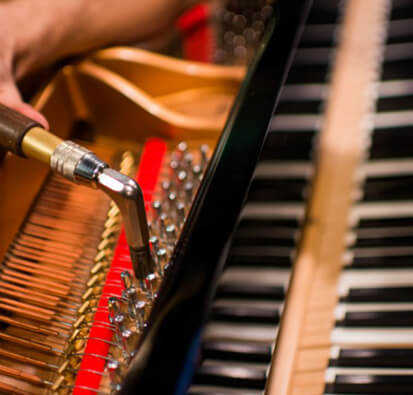Piano Tuning
Piano tuning Q & A

Since piano is a stringed instrument, which by nature will always stray off-pitch by both climate changes and play. Piano tunings are necessary if you want to keep your instrument in good condition and prevent further damage.
Correct and constant string tension is important to the health of many delicate piano parts – parts which are very expensive to fix. Regular tunings can prevent the small problems from evolving into major damage.
Regular piano tunings help to maintain the pitch at 440A, which is the international standard for the tuning of all other instruments like violin and cello. The entire pitch of a piano will keep dropping without regular tuning, and hence it will not be able to accompany other instruments which are set to international standard. In order to bring it back to normal pitch, it will take extra effort, hence extra cost!
Correct and constant string tension is important to the health of many delicate piano parts – parts which are very expensive to fix. Regular tunings can prevent the small problems from evolving into major damage.
Regular piano tunings help to maintain the pitch at 440A, which is the international standard for the tuning of all other instruments like violin and cello. The entire pitch of a piano will keep dropping without regular tuning, and hence it will not be able to accompany other instruments which are set to international standard. In order to bring it back to normal pitch, it will take extra effort, hence extra cost!
Ideally, one should have your piano tuned four times a year which is standard in many Asian countries like Hong Kong. This consistency will ultimately prolong its life. Since weather in Los Angeles is quite stable throughout the year, two tunings a year is the acceptable standard.
You should consider the following factors to set up your tuning schedule.
Local Weather
Climate extremes are bad for pianos, but fluctuations are often worse. The piano’s soundboard is particularly sensitive to this; it expands and contracts according to moisture and temperature, causing the dependent strings to slip out of tune.
If you can keep your environment at a constant ideal, you may be able to get away with two tunings per year.
The Piano’s Level of Use
Frequently-played pianos require frequent tunings. Pianos used at least five times per week need a tuning once every three months. Those used for public performances should be tuned at least once a week.
For moderately-used pianos, six months is enough time for a problem to develop, but generally not long enough for irreparable damage to occur. Two tunings per year is acceptable if you play twice a week.
Local Weather
Climate extremes are bad for pianos, but fluctuations are often worse. The piano’s soundboard is particularly sensitive to this; it expands and contracts according to moisture and temperature, causing the dependent strings to slip out of tune.
If you can keep your environment at a constant ideal, you may be able to get away with two tunings per year.
The Piano’s Level of Use
Frequently-played pianos require frequent tunings. Pianos used at least five times per week need a tuning once every three months. Those used for public performances should be tuned at least once a week.
For moderately-used pianos, six months is enough time for a problem to develop, but generally not long enough for irreparable damage to occur. Two tunings per year is acceptable if you play twice a week.
Information from
http://piano.about.com/od/pianomaintenancerepairs/tp/why_tune.htm
http://piano.about.com/od/beginnerfaq/f/Tuning_freq.htm
http://piano.about.com/od/pianomaintenancerepairs/tp/why_tune.htm
http://piano.about.com/od/beginnerfaq/f/Tuning_freq.htm
